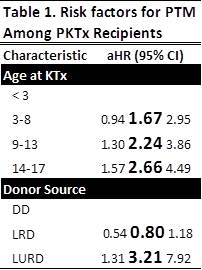Incidence of Post-Transplant Malignancy (PTM) After Pediatric Kidney Transplantation (PKTx).
1Surgery, Univ. of Minnesota, Minneapolis, MN
2Biostatistics, Univ. of Minnesota, Minneapolis, MN
3Pediatrics, Univ. of Minnesota, Minneapolis, MN.
Meeting: 2016 American Transplant Congress
Abstract number: D149
Keywords: Kidney transplantation, Malignancy, Pediatric
Session Information
Session Name: Poster Session D: Kidney-Pediatrics
Session Type: Poster Session
Date: Tuesday, June 14, 2016
Session Time: 6:00pm-7:00pm
 Presentation Time: 6:00pm-7:00pm
Presentation Time: 6:00pm-7:00pm
Location: Halls C&D
PURPOSE: Post-transplant immunosuppression is associated with an increase in cancer rates. To date, the long-term incidence of PTM among PKTx recipients has not been well-characterized.
METHODOLOGY: Between 1963 and 2015, 881 pediatric (age: 0-17 years old) recipients received 1055 KTx at our institution. The incidence and type of malignancy in this cohort was analyzed. Patient outcomes were compared and the relative risk of developing PTM after PKTx was determined.
RESULTS: After a median follow-up of 33 years, 202 PTM occurred in 136 (15.4%) patients at a median age of 29 years old. The 3 most common malignancies were cutaneous malignancies (55.0%), post-transplant lymphoproliferative disease (PTLD; 23.3%) and non-skin carcinomas (16.8%). On multivariate analysis, increasing age at KTx and receipt of a graft from a living unrelated donor (LURD) were associated with increased risk of developing PTM (Table 1). Unadjusted analysis shows excellent patient and graft survival (Fig. 1), but patients had to survive long enough to develop PTM. Median time to develop a PTM after PKTx was 18 years (Fig. 1). Of PTM patients who died during the study time period, 30/47 (63.8%) died of malignancy. The most common cause of death was PTLD (50%). Time-dependent analysis of PTM patients demonstrated a significant risk of death (aHR, 26.0 [8.0, 85.2]) and death-censored graft failure (aHR, 1.8 [1.1, 3.0]).
CONCLUSION: Increasing age at transplant and receipt of a graft from a LURD increases the risk of developing PTM among PKTx recipients, and this has a significant adverse effect on patient and graft survival long-term.


CITATION INFORMATION: Serrano O, Bangdiwala A, Vock D, Payne W, Dunn T, Chinnakotla S, Finger E, Kandaswamy R, Pruett T, Matas A, Chavers B. Incidence of Post-Transplant Malignancy (PTM) After Pediatric Kidney Transplantation (PKTx). Am J Transplant. 2016;16 (suppl 3).
To cite this abstract in AMA style:
Serrano O, Bangdiwala A, Vock D, Payne W, Dunn T, Chinnakotla S, Finger E, Kandaswamy R, Pruett T, Matas A, Chavers B. Incidence of Post-Transplant Malignancy (PTM) After Pediatric Kidney Transplantation (PKTx). [abstract]. Am J Transplant. 2016; 16 (suppl 3). https://atcmeetingabstracts.com/abstract/incidence-of-post-transplant-malignancy-ptm-after-pediatric-kidney-transplantation-pktx/. Accessed December 22, 2025.« Back to 2016 American Transplant Congress
